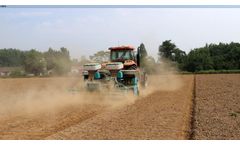Refine by
Wheat Yield Articles & Analysis
34 news found
This week, the Royal Agricultural Society of England (RASE) awarded Professor Roger Sylvester-Bradley, Head of Crop Performance at ADAS, with the RASE 2025 Science and Technology Award, in recognition of his outstanding contribution to agricultural science. For over four decades, Roger has been at the forefront of agricultural science, shaping the way we understand and manage crop performance. ...
The Yield Enhancement Network (YEN), founded by ADAS in 2012, has helped growers in the UK and North-West Europe benchmark their crop performance and identify yield restrictions to improve their productivity. ...
Wheat drill is a new agricultural technology that has been promoted. ...
“Take-all is an extremely significant and widespread fungal disease that occurs in wheat and barley, with half the UK wheat crops estimated to be affected. ...
“This will increase wheat yield and improve food security for a growing population,” Babar said. ...
Already widely used in barley and wheat crops, and showing good control of black-grass and other significant grass weeds, this comes as a welcome addition for growers of Rye and Triticale as another tool in the crop protection armoury. ...
Dairy manure has also been tested for topdressing wheat fields as part of on-farm research trials. However, dairy manure contains far less ammonia nitrogen per 1,000 gallons than swine finishing manure and does not consistently produce wheat yields similar to commercial fertilizer, Arnold said. According to the trials, adding 28 percent urea ...
As a Northumberland grower attributes his claimed world record wheat yield to fertiliser. Northumberland farmer, Rod Smith, claims to have achieved a world record wheat yield of 16.52t/ha and attributes his achievement to his usage of fertiliser. The winning technique combined 310kg/ha of nitrogen, based on a target crop ...
” Published in The Journal of Development Studies, the study found that the impact of IPRs on yields varies hugely between crops, making one-size-fits-all approaches to innovation difficult. ...
To meet the expected 60% raise in demand for wheat by 2050, coordination of research and significant investments are needed to increase wheat sustainable production globally. ...
Looking at images of his Hampshire farm, the darker blue pools indicate where there needs to be more fertiliser used, whilst the yellow areas indicate where less fertiliser is required. As a result, yields on the farm are up 3-4 per cent and the farms fertiliser bill is down 5 per cent. However, although the UK has some of the world’s highest yields for ...
The worry is that there is a potential of serious consequences for crop yields, which may include a 12 per cent drop in winter wheat yields, along with impacts on other crops, including carrots and onions. ...
To further increase agricultural productivity without compromising the environment, more innovation is required to ensure a sustainable intensification of wheat production. Embracing innovation to expand the yield frontier and exploit today’s potential Bayer CropScience has set-up a long-term innovation program to enhance global wheat ...
Climate change threatens dramatic price fluctuations in the price of wheat and potential civil unrest because yields of one of the world’s most important staple foods are badly affected by temperature rise. ...
“The most interesting feature of today’s World Agricultural Supply and Demand Estimates Report is the projected corn yield of 167.4 bushels per acre,” Farm Bureau Deputy Chief Economist John Anderson said. ...
Overall, the study’s authors say, the likelihood of a sharp drop in yields of crops vital to food supply, such as wheat and maize, is “not very high” − but global warming does markedly increase the chance of such events happening. ...
Heuer joined the ACPFG as leader of the Nutrient Use Efficiency group in January 2013 which aims to develop wheat with stable yield under stress conditions and with improved nutrient-use efficiency. ...
The researchers, Dr John Duncan, Dr Jadu Dash and Professor Pete Atkinson, all geographers at the University of Southampton, say an intensification is predicted for the recent increases in warmth in India’s main wheat belt that are damaging crop yields. The greatest impact that the hotter environment has on wheat, they say, comes from a ...
The loss of 15 000 ha of productive soils during 2003-2008 on the Emilia-Romagna Plain in Italy cost approximately €19 million in carbon storage, €100 million in wheat production and €270 million in raw materials, the researchers estimate. ...
Wheat in Ohio is nearing the critical growth stage, and with recent heavy rainfalls and the forecast calling for cooler temperatures over the next few days, growers should scout their fields for any indication of disease development, said a wheat expert from Ohio State University’s College of Food, Agricultural, and Environmental Sciences. ...











